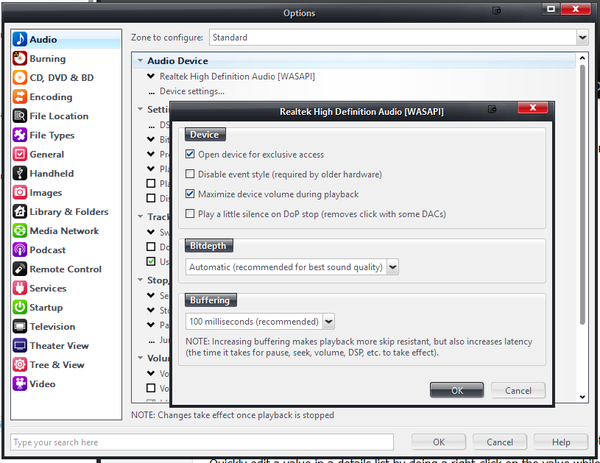WASAPI: Difference between revisions
No edit summary |
No edit summary |
||
| (33 intermediate revisions by 3 users not shown) | |||
| Line 1: | Line 1: | ||
{{See also|Audio Setup|Audio Output Modes}} |
|||
WASAPI is Microsoft's method for delivering an unmodified bitstream to a sound device. MC13 added support for WASAPI at about build 100. |
|||
The [http://msdn.microsoft.com/en-us/library/windows/desktop/dd371455%28v=vs.85%29.aspx Windows Audio Session API (WASAPI)] is Microsoft's most modern method for talking with audio devices. It is available in Windows Vista, Windows 7, and later versions of Windows. It allows delivering an unmodified bitstream to a sound device, and provides benefits similar to those provided by [[ASIO]] drivers. One of the other main benefits of WASAPI is that it provides applications with [[exclusive access]] to audio devices, bypassing the system mixer, default settings, and any typically any effects provided by the audio driver. WASAPI is the recommended [[Audio Output Mode]] for Windows ''unless'' your audio device has a well-behaved [[ASIO]] driver, and it effectively replaces all legacy output modes including [[Kernel Streaming]] and [[Direct Sound]]. |
|||
An Interact thread can be found here: |
|||
| ⚫ | |||
WASAPI support was first added to Media Center 13. Media Center 15 added event style WASAPI support, and MC 18 made this the default. |
|||
And here's a personal story from a user, Jmone: |
|||
== WASAPI Device Settings == |
|||
"My HTPC is connected to my Receiver using HDMI for both Audio and Video. I have configured Vista Audio Mixer for 5.1 (as the default) and have all my software apps decoding and outputing LPCM using WASAPI Exclusive as the audio renderer (JR WASAPI for Audio Files and Reclock for DirectShow playback). I use my HTPC for playback of all media types including Audio (CD, CD Rips, mostly in 2CH), DTV (can be in 2ch or 5.1), DVD / BluRay / Movie files (can be in 2ch or 5.1) and this is where WASAPI Exclusive is terrific as it will configure the output to the correct number of channels. The real problems it has solved for me is 2ch TV and Movie playback where the "blank" 3.1 channels stoped the Receiver using the Subwoofer for base mgt and the Center Channel for dialogue. At my age I certainly will not claim "goldern ears" and can not say that the quality between the available renderers is apparant to me. I do however easly notice the incorrect handling of 2CH material broadcast over a 5.1 configuration. Even 2ch audio sounds "better" to me when the Receiver is just getting 2ch input not 5.1 from MC." (from [http://yabb.jriver.com/interact/index.php?topic=51682.msg352820#msg352820 this thread] ) |
|||
You can access WASAPI's Device Settings in Media Center via: |
|||
<span style="color:#8B4513">Tools > Options > Audio > Audio Device > Device settings</span> |
|||
[[File:MC19-Audio-WASAPI Device Settings.png|thumb|600px|none|Options available for WASAPI connected devices.]] |
|||
| ⚫ | |||
From here you can: |
|||
* Enable [[Exclusive access]] of the audio device. |
|||
* Disable [[WASAPI Event Style]] for supporting older hardware. |
|||
* Set Media Center to [[Maximize device volume|automatically maximize the audio device's system volume control]] during playback. |
|||
* Alter Buffering settings if needed to deal with troublesome hardware or drivers. |
|||
* Enable the Play a little silence option which can help prevent clicks and pops when starting and stopping playback that occurs on some audio devices |
|||
== More == |
|||
| ⚫ | |||
| ⚫ | |||
[[Category:Audio]] |
|||
Latest revision as of 06:13, 17 April 2014
- See also: Audio Setup and Audio Output Modes
The Windows Audio Session API (WASAPI) is Microsoft's most modern method for talking with audio devices. It is available in Windows Vista, Windows 7, and later versions of Windows. It allows delivering an unmodified bitstream to a sound device, and provides benefits similar to those provided by ASIO drivers. One of the other main benefits of WASAPI is that it provides applications with exclusive access to audio devices, bypassing the system mixer, default settings, and any typically any effects provided by the audio driver. WASAPI is the recommended Audio Output Mode for Windows unless your audio device has a well-behaved ASIO driver, and it effectively replaces all legacy output modes including Kernel Streaming and Direct Sound.
WASAPI support was first added to Media Center 13. Media Center 15 added event style WASAPI support, and MC 18 made this the default.
WASAPI Device Settings
You can access WASAPI's Device Settings in Media Center via: Tools > Options > Audio > Audio Device > Device settings
From here you can:
- Enable Exclusive access of the audio device.
- Disable WASAPI Event Style for supporting older hardware.
- Set Media Center to automatically maximize the audio device's system volume control during playback.
- Alter Buffering settings if needed to deal with troublesome hardware or drivers.
- Enable the Play a little silence option which can help prevent clicks and pops when starting and stopping playback that occurs on some audio devices
